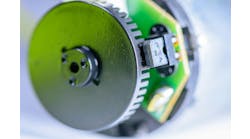For shaft speed and position control, the sensing options are a rabbit hole. Deciding between an encoder and a resolver is simple enough, but it’s just the first step. Then, there’s the difference between an incremental encoder and an absolute encoder. If an incremental rotary encoder is appropriate for the application, there are multiple choices with optical, magnetic and capacitive. Our panel of experts discusses which encoder or resolver to use when and more.
QUESTION
Why are so many different types of solutions available, and is there a checklist that can guide machine builders and help controls engineers to navigate the rabbit hole to find the right solution?
ANSWERS
Mahendra Muli, director of marketing and new business development, dSPACE: Sensor technology has advanced significantly to generate a wide portfolio of solutions that could match every specific requirement. However, often the specification of the sensor alone may not be sufficient for engineers to answer if a particular sensor type, other than the physical attributes, will completely match the requirements of the application.
With increasing use of embedded control systems, the applications can deliver a very precise and very reliable performance. The faster and cheaper microcontrollers, processors and FPGAs are often used with complex control system software.
So, how do the engineers choose the sensors and verify the overall system performance with a specific sensor before committing to it? The answer lies in simulation. By simulating the sensor signals and the overall software, engineers can ensure that the system meets the performance characteristics. Additionally, through simulation, engineers can also simulate abnormal behavior and errors without even having the physical sensors.
DSPACE, in addition to our rapid controller prototyping systems, also provides hardware to support control system development by simulation of both physical system as well as all of the sensors in the system. With such a system, referred to as hardware-in-the-loop (HIL), engineers can simulate the dynamic behavior of the mechanical components of the system, including all of the sensors for interfacing to the controller board. The dynamic behavior of the mechanical device can be programmed to simulate real-life normal and abnormal conditions, as well as failure conditions in the system.
Ivan Masek, president, Novotechnik U.S.: The reason for so many types of rotary sensors is the fact that there are many different applications to cover regarding precision, mechanical requirements and electrical output options plus the different environments. As the sensor market is huge, it makes a lot of sense to build exactly what is needed for a certain application and provide the optimum in cost and performance. In many, but far from all, cases this requires customized versions of standard products.
Use absolute position sensors in applications where you need to know the position exactly after a power outage and cannot move back to an index switch. In most other applications, incremental can be a more cost-efficient way to go. For ultra-high precision in a controlled manufacturing environment, use optical encoders, though for many applications this degree of precision is not needed.
I recommend talking to an application engineer from a manufacturer that shows applications similar to yours shown on his application Web pages. This person can guide you very quickly to a tailored solution by asking detailed questions on performance and environmental requirements as well as size and cost.
This is just a couple answers we received from industry experts.
We've compiled the rest of the suggestions along with interesting applications, things to watch out for, and more into an expanded report you can download for free for easy reference.
→ Our report, "How to navigate the encoder/resolver rabbit hole," can be downloaded here.





